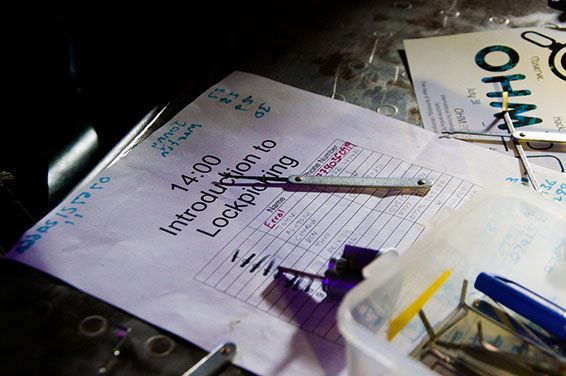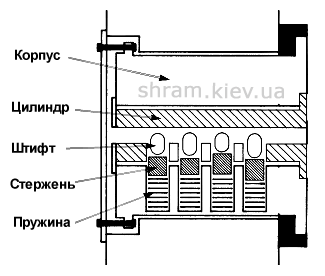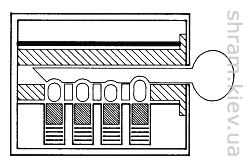Steve Arnold's article "Introduction to the ability to open locks" (An Introduction to Lock Picking)

My interest in breaking the locks is based on three things. Firstly, I was always amazed and somewhat envious of the characters from the films, which could easily penetrate into any room. The mastery they possessed was always under the cover of secrecy, which made it even more attractive. And I was later very surprised that even with a simple set of tools, little knowledge and practice, almost anyone can open most of the locks.
I have also been interested in all sorts of puzzles and riddles for a long time, which is also close to opening the locks (for the lock is the same mechanical riddle). Even when you fully understand the device and the principle of the lock, an attempt to open it without a key will require you to be very ingenious, concentrated and agile.
Here I would like to remind you once again that trying to open a lock without the owner's knowledge (especially if it is done to illegally penetrate someone else's property) can lead you to the dock.
However, sometimes there are quite legal situations when it is necessary to open any door without a key (for example, if you lost the key from your own door). In this case, it may be very unpleasant to break doors, resulting in undesirable damage and subsequent repairs. Then, with a little time and patience, most of the usual internal locks can be easily opened.
In this article, I want to describe the popular type of locks with a pin-type cylinder mechanism. This type of locking mechanism is found all over the world and is used both in padlocks and in locks for interior doors. The illustrations in this article will help you to understand what parts of a similar lock consists of and how these parts can be manipulated. Keep in mind that you can ruin the castle as a result of your experiments, so I strongly recommend that you stock up on this old and already unnecessary lock. In addition, at the old castle you can safely change the sequence of pins, which will allow you to increase your skill.
LOOK INTO HISTORY
Mechanical locks have been around for thousands of years. Earlier, castles belonged only to rich people, but they were very simple in design and, in comparison with modern locks, very simply opened.
The mass production of door locks began in the early 18th century. As the design of locks became more complex, an engineer named Joe-zef Brahmach invented, as he was told, an unopened lock. In 1767, this castle was presented in the shop window with a statement that the first person to open this castle will receive 200 guineas. Since the castle had almost 500 million combinations for the key, it's no surprise that no one has been able to do this for 64 years!
Public interest increased as the struggle between factory and craft production of castles increased. In the middle of the 19th century, the door lock market quickly expanded, and each company struggled for its market share, stating that they were producing the most reliable mechanism. Talented mechanics came up with more and more reliable mechanisms. So the name of Jeremy Chubb is associated with his remarkable version of the lever lock, most commonly found now in mortise locks.
A.S. Hobbs was an American fitter who came to England in order to "make a name for himself." At that time there was a great rivalry between American and English castles manufacturers. The arena for their battles was, of course, London, and it was there that Hobbs arrived to establish himself. At first he "attacked" Chabb's castle, opening it quickly and with apparent ease, to the great dismay of the company that produced it. Then everything was prepared, so that Hobbs tried to open the famous castle of Joseph Bramakh. Hobbes worked on the castle, being under constant supervision, 44 hours for 10 days. Finally the castle was opened, and Hobbs could repeatedly close and open it. AS Hobbs became famous and prospered in this country as a remarkable locksmith.
Locks and safety were of great public interest and were of great importance in the art of escape, which formed into a popular hobby of that time. Escape is an art of getting out of handcuffs, tightly enclosed spaces, etc. Harry Houdini was one of the most famous masters of this art. At that time opening of locks became quite legal entertainment and ceased to be the prerogative of fitters or criminal elements.
CASTLE WITH CYLINDER PULLEY MECHANISM
A lock of this type consists of a body and an inner cylinder. Several holes located along the body coincide with the corresponding holes in the cylinder. This allows the rods, which are located inside the shell, to enter adjacent holes in the cylinder. The rods are supported by springs, so that when the key is not inserted into the lock mechanism, they automatically slide out into the cylinder and prevent it from rotating.

When the correct key is inserted into the locking mechanism, the rods are positioned in a position that allows the cylinder to rotate inside the housing. This movement leads to locking or unlocking the lock.


The key inserted into the lock propels the rods until their upper surface is aligned with the outer surface of the cylinder. The key does not directly touch the rods, but its profile is transmitted to the rods through the pins. Each pin can be different in length to reflect the key profile. As a result, the pins fill the wavy profile of the key, allowing all the rods to align with the outer surface of the cylinder.
This type of locks is preferably made of a soft non-ferrous metal, such as brass. Quality locks can have six or more sets of rods / pins. The rods can be of different designs to improve the reliability of the lock. Standard rods are cut from a round bar and have a straight cylindrical shape. In order to complicate the opening of such locks, sometimes some rods have the shape of a fungus or the shape of the letter "I". Cheaper locks or old locks with diffuse mechanisms are more likely to be opened.
INSTRUMENTS
Two types of tools are needed to carry out manipulations with the lock. The first one is called the "rotator" (approximate translation from English Tension Wrench) and is intended to apply a rotational force to the moving part of the lock. The second tool is actually the master key, which is necessary to set the pins in the required position.
The rotator is inserted into the bottom of the key slot and has a 90 degree bend at the base to form the handle. This makes it possible to apply a slight but constant rotational force to the cylinder of the lock.
Lock picks come in a variety of designs, depending on the technique used to dissect. Lock picks with thin or dotted ends are used to act on individual pins. Those that have convex or rounded ends are used for methods of influencing several pins (see the section on opening technique below). The master key must be thin and narrow so that it can be inserted over the spinner and reach the pins.

The third tool, which can also be used frequently, is the puller of a broken key. There are several types of such tools that pull out the wrench fragments and release the key hole.
EQUIPMENT
Whichever method is used, it is first necessary to insert a rotator into the bottom of the key slot. Then a non-strong lateral pressure is applied, i.e. Rotary motion is applied to the cylinder of the lock. It is necessary to be careful to apply this movement in the right direction - in the direction of unlocking the lock. At first glance this seems obvious, but, unfortunately, the right direction is not always known, and the wrong way leads to wasted time.
Impact on single pins.
While a small load is applied to the cylinder, the rods are clamped between the cylinder and the body along their connection line. Rods and pins are most often made with a small tolerance in size, and in conjunction with wear, this leads to a difference in thickness of these parts. This means that at least one of the pins will be clamped more tightly along the cylinder-housing connection line than the rest. Using the picklock with a dotted end, you need to sort through all the pins to determine which of them is pinned stronger than the others. Then you need to press on this pin until you feel a slight rotational movement of the cylinder. While the pin, pressing the rod, lowers it to the line connecting the cylinder and the body, the cylinder slightly turns and clamps the next most tightly seated pin / rod.
With each rod, the same operation is performed, while the rotator must always be under load. Each time a rod is selected which is most tightly pressed. When all the pins are lowered to the desired level, the cylinder will turn and act on the lock mechanism.

This is a very neat method, requiring great dexterity. Remember, only practice will help you to comprehend it!
Impact on several pins.
In this method, a skeleton with a rounded end is used to pass along the pins. With this passage, the pick pick up and lower the pins / rods and at the moment when the surface of one of the most closely fitting rods coincides with the line of the inner surface of the body, the cylinder rotates slightly, etc.
I find this method random and not very effective, working mainly on old worn locks.
DEVICES FOR HIGH SECURITY OF THE LOCKS
In order to make such locks more difficult to break, new types of rods were invented. Usually two bars in the lock are made in the form of the letter "I" .

These devices give a false movement when using the single-action method, which greatly complicates the process of opening the lock.
In this case, the method of influencing several pins is more applicable.
Materials are taken from books, magazines, other sources, bought in e-shops, received by exchange. Provided are "AS IS" ("AS IS"); Check the performance of each is not possible. The site www.shram.kiev.ua works, rather, as a paid search system for interesting materials.
There are no materials on sale that contain warnings about the prohibition of its distribution (paid or free of charge). If you notice a copyright infringement (the sale of the material, for free distribution and sale of which its author did not give permission) - report, the material will be removed.




Comments
Commenting on, remember that the content and tone of your message can hurt the feelings of real people, show respect and tolerance to your interlocutors even if you do not share their opinion, your behavior in the conditions of freedom of expression and anonymity provided by the Internet, changes Not only virtual, but also the real world. All comments are hidden from the index, spam is controlled.